
Glaumbaer is an open-air museum featuring a traditional turf farm and timber buildings that showcase 18th and 19th-century life in Iceland. It's located in the Skagafjordur fjord in North Iceland, close to the town of Saudakrokur.
The Glaumbaer turf farm is a historical site and museum in North Iceland's Skagafjordur fjord. Its history traces back to the 11th century, but the houses currently standing on the farmland were built in the 18th and 19th centuries. They're notable examples of traditional Icelandic architecture from that period.
Why You Can Trust Our Content
Guide to Iceland is the most trusted travel platform in Iceland, helping millions of visitors each year. All our content is written and reviewed by local experts who are deeply familiar with Iceland. You can count on us for accurate, up-to-date, and trustworthy travel advice.
Today, Glaumbaer is part of the Skagafjordur Heritage Museum, one of the best museums in Iceland. The farm offers insight into the daily life of Icelanders, including living conditions and farming practices, along with Iceland's architectural evolution and cultural heritage.
Glaumbaer is a 15-minute drive from the town of Saudarkrokur and an hour's drive from Akureyri, the "Capital of the North." You can visit with a rental car during relaxed self-drive tours or when driving the Ring Road
One of the best options for a visit is during this 7-day self-drive tour of North Iceland's Arctic Coast Way, where you can make a quick detour to Glaumbaer on your way to Akureyri.
History of the Glaumbaer Turf Farm

Glaumbaer in the early 20th century. Photo from the Skagafjordur Heritage Museum
The first farmer in Glaumbaer is believed to be Snorri Þorfinnson in the 11th century. He is famously said to be the first European child born in North America, as his mother, Guðríður Þorbjarnardóttir, was a great explorer and likely the most traveled woman of her time. You can see a statue of her outside the Glaumbaer church and by her childhood home on the Snaefellsnes peninsula.
Glaumbaer stayed in private ownership until the 16th century when it became church property and a pastor's residence. The buildings you can visit today were built in 1879 and were repaired in 1947 when the last inhabitants of the farm moved out, and it was declared a conserved site.
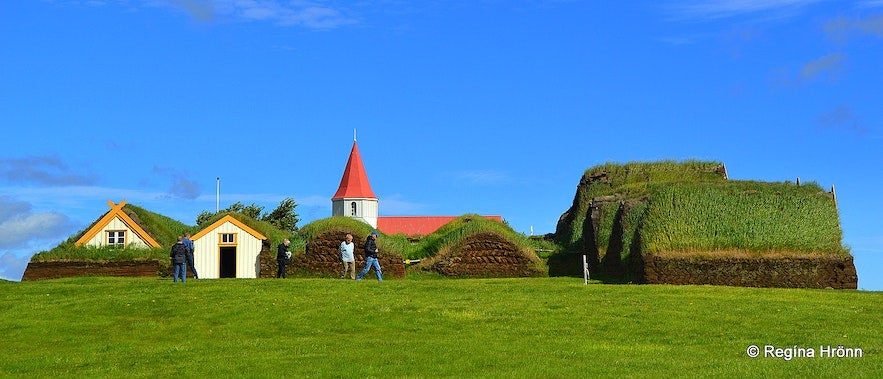
Photo from Regína Hrönn Ragnarsdóttir
A key characteristic of the Icelandic building tradition of the time is that farms were composed of multiple small buildings that were connected with tunnels, which you can see when exploring Glaumbaer. You'll see 13 connected houses during your visit, with each one serving a specific function, such as a kitchen, pantry, smithy, and more.
Like a typical turf house, Glaumbaer was built from specially cut turf and rocks, and the inside is supported by a wood frame and paneling. Next to Glaumbaer, you can visit Ashus and Gilsstofa, two late 19th-century timber houses from the region that give insight into the building style that came to replace the traditional turf house. They were moved to the Glaumbaer museum in the 1990s and house exhibitions and a café.
What to See at the Glaumbaer Museum
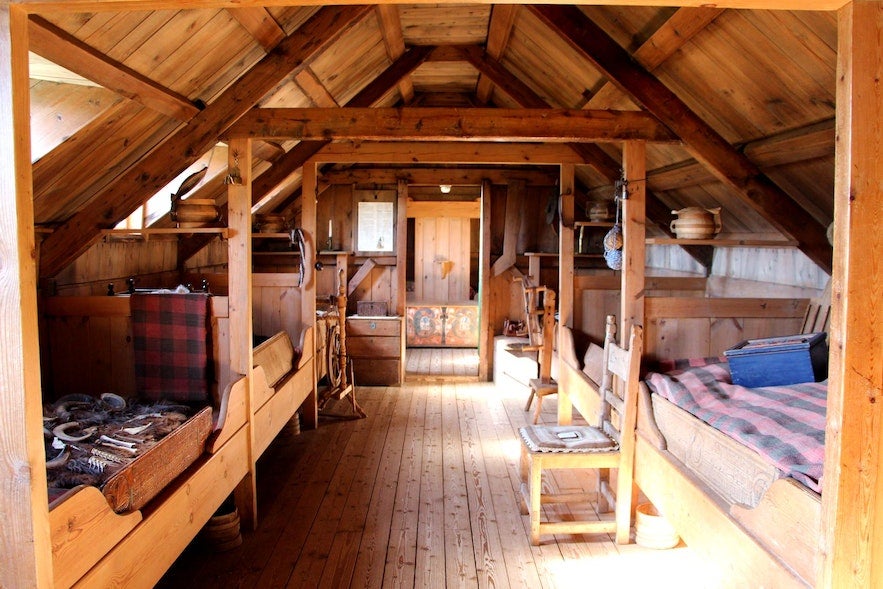
Historically, Icelanders would spend most of their indoor time in the "Baðstofa," a communal working and sleeping space.
When visiting Glaumbaer, you can walk freely around the surrounding farming area and explore the Glaumbaer turf house along with the Ashus and Gilsstofa timber houses. This farm is larger than the average person would have been used to at the time, but it gives a glimpse into Icelandic upper-class life in the 18th and 19th centuries, complete with furnishings.
These buildings have historical exhibitions dedicated to different factors of life in Glaumaer through the ages. As you explore the turf house, you'll learn about the living conditions and daily life of Icelanders, see how they stored and prepared their food, how they worked, and more.
In the two timber buildings, Gilsstofa and Ashus, you'll find temporary exhibitions covering different aspects of daily life in Iceland, so make sure to see what's on display during your visit.
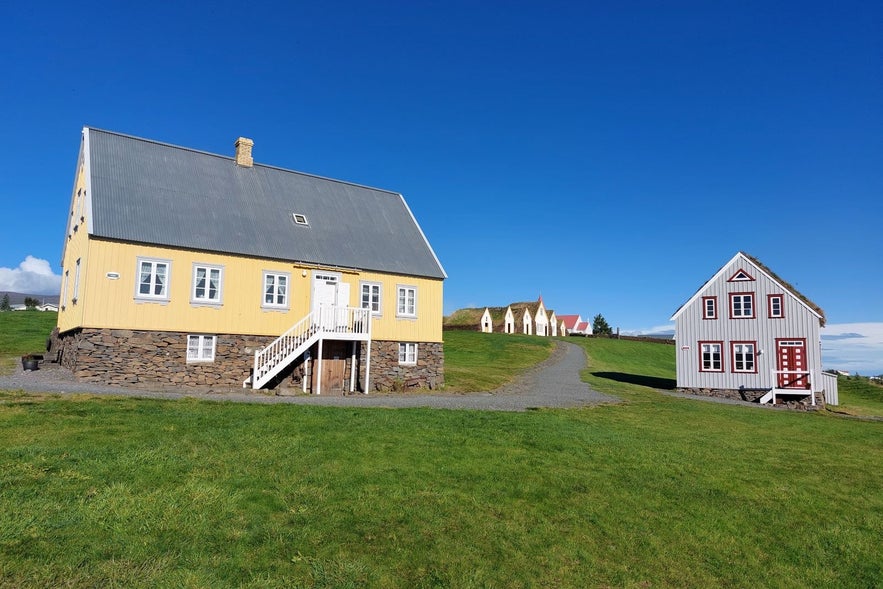
Ashus to the left and Gilsstofa to the right
One of the prominent exhibitions is located in the loft of the Ashus building, which is dedicated to Monika Helgadóttir, a celebrated local woman who's said to have embodied the essence of the Icelandic farm woman. She received the Icelandic Order of the Falcon in 1953 for her resilience in farming under harsh conditions, and a year later, a book was published about her life.
In the same building, there's a charming café where you can treat yourself to the soup of the day, fresh cakes, and traditional treats in a homey setting. Afterward, stop by the small gift store by the museum exit, where you'll find souvenirs, history books, and handcrafts from the surrounding area.
Opening Times and Best Time to Visit

Photo from Wikimedia, Creative Commons, by Gerd Eichmann.
For the best experience in Glaumbaer, plan a summer visit. It's much easier to travel around Iceland during this time, and visiting an outdoor museum is more enjoyable in good weather.
The Glaumbaer turf farm has regular opening times during the warmer months. From late May to late September, it's open daily. If you're visiting Iceland between late September and October or April and mid-May, be aware that it's closed on weekends.
Glaumbaer is closed between late October and March, but you can request to visit by contacting the museum ahead of time.
How to Get to the Glaumbaer Museum
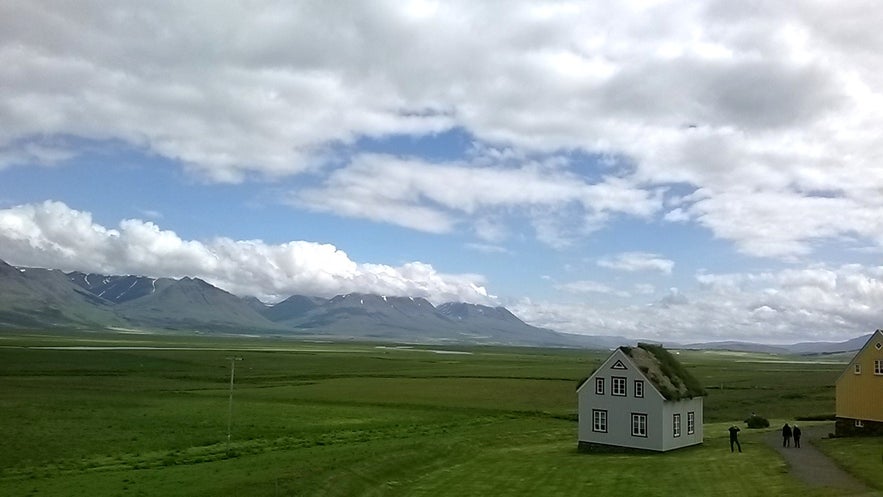
Photo from Wikimedia, Creative Commons, by Reykholt.
The Glaumbaer turf farm is located along a lush hillside in Skagafjordur fjord. If you're planning a summer self-drive adventure, you only need a small rental car to reach the museum. If you're visiting Iceland in winter it's best to navigate the northern region with a 4x4 vehicle.
Glaumbaer is just a 7-minute drive from the village of Varmahlid, which sits along the Ring Road. It's a popular rest stop when driving from Reykjavik to Akureyri, so you can easily include a quick detour to the Glaumbaer museum.
Attractions Near the Glaumbaer Museum
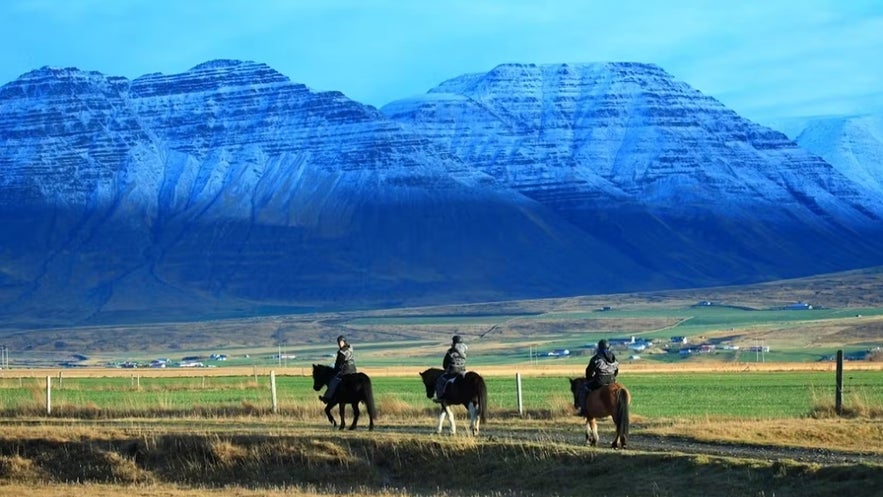
Photo from Family-Friendly 1-Hour Horseback Ride in the Heart of North Iceland’s Countryside
Skagafjordur fjord is a very historically significant area. You'll find multiple historical sites from the Icelandic Sagas, including the location of the 1238 battle of Orlygsstadir, the largest one in Iceland's history. You can learn more about it and other significant events of that time at the 1238 Battle of Iceland exhibition in Saudakrokur and experience it through virtual reality!
On the other side of the Skagafjordur fjord, you can visit Holar in Hjaltadalur, which used to be one of Iceland's two episcopal seats. It's known for its cathedral, and it's the location of Holar University. A 25-minute drive away, you can visit the Icelandic Emigration Center in Hofsos, a museum dedicated to the history of Icelandic emigration to North America.
The surrounding nature of the Skagafjordur fjord offers great opportunities for outdoor adventuring, like this family-friendly 1-hour horseback ride through the northern landscapes or even this 3-hour whitewater river rafting tour for more thrills!
If you want to expand your visit to the Skagafjordur area, it's best to either stay in accommodation in Varmahlid or travel a bit further to Saudarkrokur, the largest town in the vicinity. You can also find fantastic Akureyri hotels, guesthouses, and cottages just an hour's drive away!









